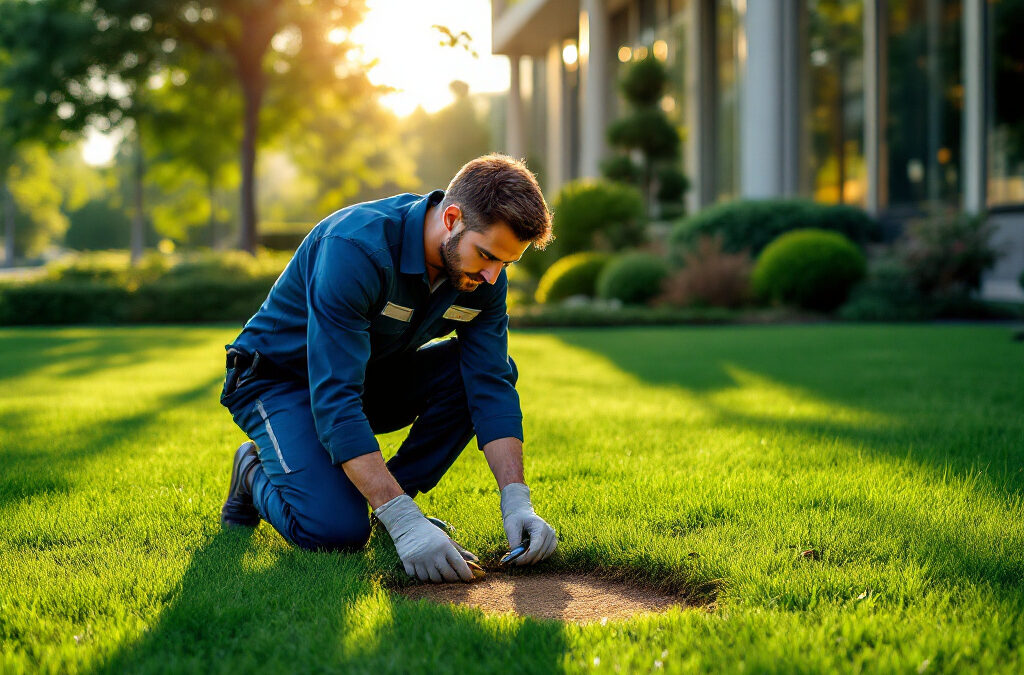Maintaining a healthy lawn in commercial properties is crucial for enhancing aesthetics and maintaining property value. A well-kept lawn not only attracts potential clients but also promotes a positive image for the business. However, common lawn diseases can significantly impact the vitality of grass, leading to unsightly patches and a decline in the property’s overall appeal.
Understanding Lawn Diseases
Definition of Lawn Diseases
Lawn diseases are typically harmful afflictions that affect grass and turf, often resulting from fungi, bacteria, viruses, or unfavorable environmental conditions. These diseases can lead to weak, unhealthy lawns that are more susceptible to pest infestations and environmental stress. Identifying and addressing these diseases promptly is essential for preserving the health of your lawn.
Common Types of Lawn Diseases
Several common lawn diseases threaten commercial properties:
- Fungal Infections: Diseases such as Brown Patch and Dollar Spot are prevalent, particularly in warm and humid conditions. They manifest as irregular patches of brown or dead grass.
- Bacterial Diseases: Leaf Spot is a well-known bacterial disease that can cause unsightly spots and weaken the lawn’s overall health.
- Viral Diseases: The Mosaic Virus can lead to mottled, yellowing leaves, diminishing the aesthetic quality of your lawn.
- Environmental Issues: Factors like poor drainage and soil compaction can create a breeding ground for these diseases while making it difficult for the grass to thrive.
Signs and Symptoms of Common Lawn Diseases
Recognizing the signs and symptoms of lawn diseases is crucial for early intervention. Common visual indicators include discoloration, often appearing as yellowing or browning patches, and wilting of the grass. Additionally, changes in grass texture, such as thinning or bare spots, can indicate an underlying issue. Be aware that seasonal variations can also affect when and how disease symptoms appear, typically during stressful weather conditions.
Preventive Measures for Lawn Diseases
Proper Lawn Maintenance Techniques
A well-maintained lawn can significantly reduce the risk of lawn diseases. Implementing effective mowing practices, such as maintaining the correct height, allows for healthier grass that can better withstand stress. Additionally, adhering to proper watering schedules—preferably deep and infrequent—to avoid over-saturation can drastically improve lawn health. Understanding the right fertilization guidelines, such as using slow-release fertilizers, can also bolster your grass’s resilience.
Soil Health Management
Healthy soil is the foundation of a vibrant lawn. Routine aeration practices, such as core aeration, improve soil structure by enhancing air exchange and promoting root growth. Conducting soil tests helps you identify nutritional deficiencies and enables you to make informed amendments, ensuring optimal soil conditions for your grass.
Choosing Disease-Resistant Grass Varieties
Selecting disease-resistant grass varieties is an effective long-term strategy. These grasses are bred to resist common diseases and environmental stresses, reducing the likelihood of future outbreaks. Collaborating with your local nursery or lawn care experts can help you choose the best grasses suited for your climate and soil conditions.
Regular Inspections and Monitoring
Consistent inspections and monitoring are crucial for early disease detection. Regularly observing your lawn for changes in color and growth can help catch potential issues before they escalate into larger problems. Make it a habit to observe seasonal fluctuations, as many diseases thrive under specific temperature and moisture conditions.
Treatment Options for Lawn Diseases
Chemical Treatments
When diseases do occur, various chemical treatments can provide effective relief. Fungicides are widely used to combat fungal infections; however, correct application timing and methods are imperative for efficacy. Bactericides can also be useful in managing bacterial diseases, but they should be used judiciously to avoid harming beneficial microorganisms in the soil.
Organic and Natural Treatment Options
For those looking for eco-friendly solutions, organic and natural treatments can be effective. Antifungal neem oil is a popular option that disrupts the life cycle of various pathogens while being safe for the environment. Additionally, biological control methods, such as introducing beneficial nematodes, can help manage pest populations and improve soil health naturally.
Cultural Practices Post-Disease Outbreak
After a disease outbreak, implementing cultural practices is essential for restoring your lawn. Reseeding affected areas not only helps in recovery but also reinforces grass density. Improving lawn drainage and aeration after an outbreak can significantly enhance conditions that may lead to renewed health and vitality in your lawn.
When to Call in a Professional
Identifying the severity of a lawn disease can be challenging, and sometimes it’s best to consult with a professional. Lawn care experts possess the skills and knowledge to accurately diagnose problems and provide targeted treatment options. Before hiring a professional, consider factors such as cost, the expertise of the services offered, and the treatments they recommend to ensure the best outcome for your lawn.
Conclusion
In summary, taking proactive steps to prevent and treat common lawn diseases is vital for maintaining the health and beauty of commercial properties. Regular inspections and vigilant maintenance techniques can significantly reduce the risk of disease, while prompt treatment can bring your lawn back to life when issues arise. Prioritizing the health of your lawn is an investment that pays dividends in aesthetics and property value.
We encourage you to give us a call today at 916-562-2345 to get a quote and keep your commercial lawn disease-free and looking its best year-round.


